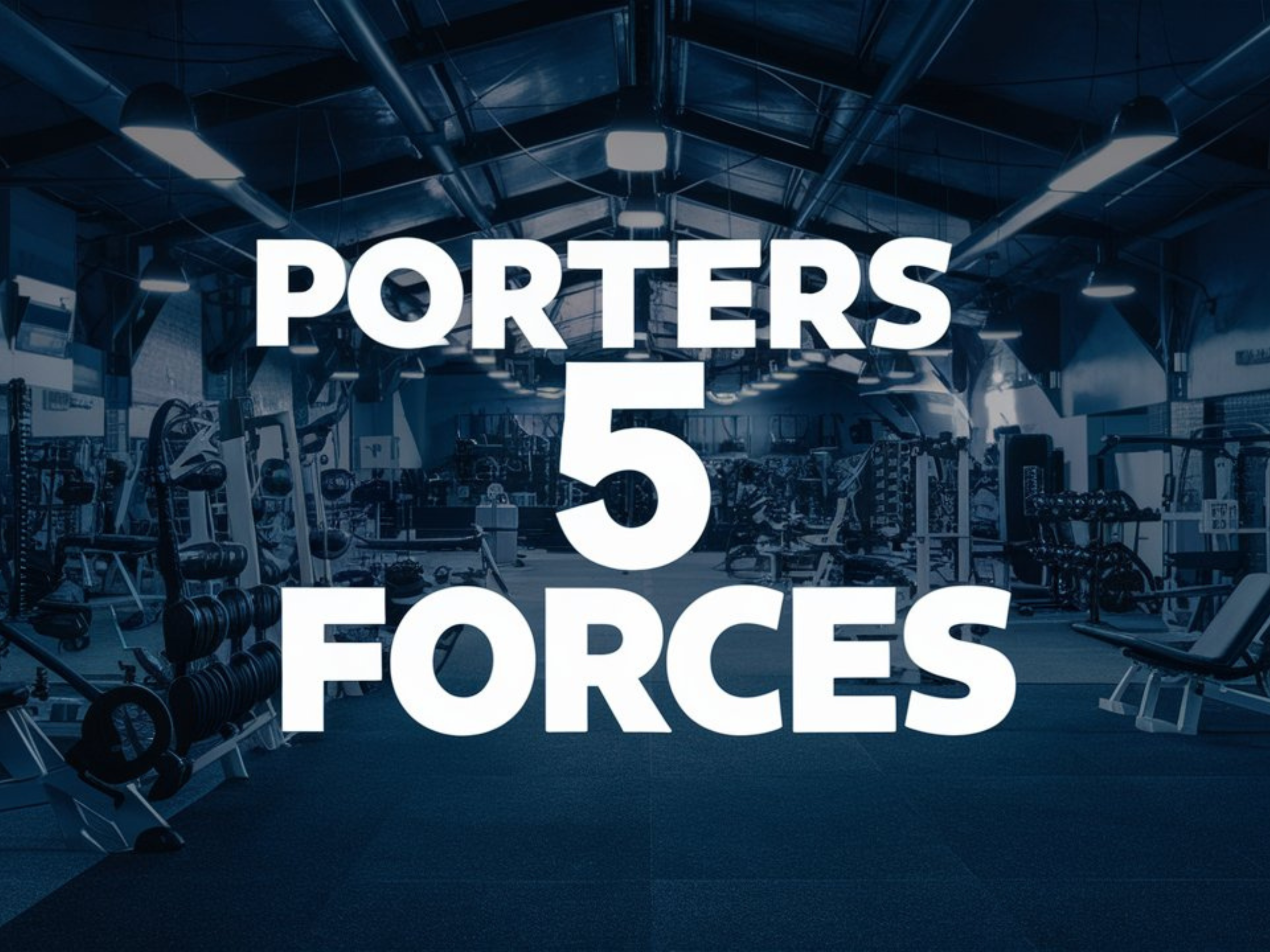In the ever-evolving landscape of business strategy, the keyword “Porter’s Five Forces” stands as a beacon of wisdom. In this blog post, we embark on a journey to unravel the power and potential of Porter’s Five Forces model, a quintessential framework that empowers businesses to dissect their competitive environments, make informed decisions, and chart a course toward sustainable success. Whether you’re a seasoned strategist or a newcomer to the world of business analysis, this guide will equip you with the knowledge and tools to navigate the intricate dynamics of your industry. Join us as we explore the ins and outs of Porter’s Five Forces and unlock its secrets to strategic excellence.
Bite Size ‘Simple Steps’ (TLDR) – 5 Steps to Implement Porter’s Five Forces Model in a Digital Fitness Business
- Define Your Industry
- Explanation: Clearly delineate the boundaries of the digital industry or market segment you want to analyze.
- Example: An online subscription-based fitness platform identifies its industry as the digital fitness market.
- Identify Key Players and Gather Data
- Explanation: List major competitors, suppliers, customers, and potential substitutes. Collect relevant data about these players.
- Example: The fitness platform lists competitors like other online fitness apps, suppliers like video hosting services, and potential substitutes like YouTube fitness channels and traditional gym memberships.
- Analyze Each of the Five Forces
- Explanation: Conduct a thorough analysis of each force (Threat of New Entrants, Bargaining Power of Suppliers, Bargaining Power of Buyers, Threat of Substitute Products, and Competitive Rivalry) using collected data.
- Example: The fitness platform analyzes the threat of new entrants by assessing the ease of launching new fitness apps and evaluates supplier power by looking at the number of available cloud service providers.
- Rate and Prioritize the Forces
- Explanation: Assign a rating to each force based on its strength and potential impact on your business. Prioritize the forces that need strategic attention.
- Example: The fitness platform rates competitive rivalry as high due to many similar apps and rates the bargaining power of suppliers as moderate because there are several video hosting platforms.
- Develop and Implement Strategies
- Explanation: Formulate strategies to address each force based on its rating and impact. Implement these strategies in your business operations.
- Example: The fitness platform decides to focus on differentiating its product by offering exclusive workout content and superior user experience. It also negotiates long-term contracts with cloud service providers to stabilize costs.

What Is Porter’s Five Forces Model?
Porter’s Five Forces is a fundamental framework developed by Michael Porter, a renowned Harvard Business School professor and strategist. This model serves as a valuable tool for assessing the competitive environment of an industry or market. It enables businesses to understand the dynamics at play and make informed decisions.
Understanding the Five Forces
Porter’s Five Forces model consists of five key elements, each representing a distinct aspect of a market’s competitiveness:
a. Threat of New Entrants:
- This force assesses how easy or difficult it is for new competitors to enter a market.
- Factors to consider include barriers to entry such as capital requirements, economies of scale, and government regulations.
- High barriers mean less threat, while low barriers invite more competition.
b. Bargaining Power of Suppliers:
- This force focuses on the influence suppliers have over businesses in an industry.
- Powerful suppliers can raise prices or limit the availability of crucial inputs.
c. Bargaining Power of Buyers:
- Here, the attention is on the influence buyers (customers) wield in the market.
- Strong buyer power means they can demand lower prices or better quality.
- A weak buyer position implies less influence on pricing and terms.
d. Threat of Substitute Products:
- This force examines the potential for alternative products or services to replace what’s currently in the market.
- The higher the threat, the more challenging it is for businesses to maintain market share.
e. Competitive Rivalry:
- Competitive rivalry assesses the intensity of competition among existing firms in the industry.
- A highly competitive market often leads to price wars and reduced profitability.
- Consider using a chart to visualise the competitive landscape in a specific industry.
Understanding these forces collectively provides a comprehensive view of the competitive landscape within an industry. By analysing and evaluating each force, businesses can develop strategies to mitigate threats, seize opportunities, and make informed decisions.
Benefits of Using Porter’s Five Forces Model
Porter’s Five Forces model offers several compelling advantages for businesses and strategic decision-makers:
a. Informed Decision-Making:
- Using this model helps organisations make well-informed decisions by providing a structured approach to assess market conditions.
b. Competitive Insight:
- It provides valuable insights into the competitive landscape, allowing businesses to identify potential threats and opportunities.
- This insight helps companies develop strategies to stay ahead in their industries.
c. Risk Mitigation:
- By understanding the forces at play, businesses can proactively mitigate risks and challenges.
- Identifying high-risk areas allows for effective risk management strategies.
d. Strategy Development:
- Porter’s Five Forces aids in the formulation of robust business strategies.
- Businesses can tailor their approaches based on the unique characteristics of their industry.
e. Sustainable Competitive Advantage:
- Leveraging the model can help organisations establish and maintain a sustainable competitive advantage.
- Businesses can build defensible positions in the market.
Step-by-Step Guide to Using Porter’s Five Forces
Now, let’s explore a step-by-step guide to effectively apply Porter’s Five Forces model in your business strategy:
Step 1: Define Your Industry:
- Start by clearly defining the industry or market segment you want to analyse.
- Ensure that the boundaries of your analysis are well-defined for accuracy.
Step 2: Identify Key Players:
- List the major players in the industry, including both competitors and suppliers.
- Consider the influence and market share of each player.
Step 3: Analyse the Five Forces:
- For each force (Threat of New Entrants, Bargaining Power of Suppliers, Bargaining Power of Buyers, Threat of Substitute Products, and Competitive Rivalry), conduct a thorough analysis.
- Use available data and research to assess the force’s impact on your industry.
Step 4: Rate Each Force:
- Assign a rating to each force, indicating its strength or weakness.
- This step helps prioritise areas that require strategic attention.
Step 5: Develop Strategies:
- Based on your analysis and force ratings, formulate strategies to address each force.
- These strategies should align with your organisation’s goals and competitive position.
Step 6: Monitor and Adapt:
- Continuously monitor changes in the industry and adjust your strategies accordingly.
- Adaptation is key to maintaining competitiveness over time.
By following this systematic guide and utilising Porter’s Five Forces model, businesses can gain a comprehensive understanding of their competitive environment, make informed decisions, and develop strategies that enhance their market position.
Industry Examples
To gain a deeper understanding of how Porter’s Five Forces model works in real-world scenarios, let’s explore some industry-specific examples where businesses have effectively used this framework:
a. The Smartphone Industry:
- In the highly competitive smartphone industry, the threat of new entrants is relatively high due to low barriers to entry, but competitive rivalry among established players, such as Apple and Samsung, is intense.
- Suppliers, such as semiconductor manufacturers, have considerable power due to their specialised components.
- Buyers, on the other hand, have substantial power due to the availability of many brands and models.
- The threat of substitute products is present, as consumers can opt for alternatives like tablets or laptops.
b. The Airline Industry:
- In the airline industry, high capital requirements and strict regulations pose significant barriers to new entrants, leading to a lower threat in this regard.
- Suppliers, including aircraft manufacturers and fuel providers, exert substantial influence on airlines.
- Buyers (passengers) have moderate power, with choices based on factors like pricing, routes, and services.
- The threat of substitute transportation modes, such as trains or buses, is a consideration.
Common Mistakes to Avoid
While Porter’s Five Forces is a powerful tool, it’s essential to be aware of common mistakes that can hinder its effective use:
a. Superficial Analysis:
- One common mistake is conducting a shallow analysis that oversimplifies the complexity of the industry.
- Avoid merely scratching the surface; delve deep into each force to uncover valuable insights.
b. Neglecting Dynamic Factors:
- Some businesses make the error of treating the Five Forces as static, ignoring changes in the industry over time.
- Regularly update your analysis to adapt to evolving market conditions.
c. Ignoring Complementary Strategies:
- Focusing solely on combating negative forces can lead to missed opportunities.
- Consider complementary strategies that harness favourable forces to your advantage.
d. Lack of Market Research:
- Inadequate data and research can lead to incorrect assessments of forces.
- Ensure your analysis is based on accurate, up-to-date information.
e. Failure to Adjust Strategies:
- After conducting a Five Forces analysis, some organisations fail to adjust their strategies accordingly.
- Use the insights gained to inform strategic decisions and actions.
f. Relying Solely on the Model:
- Porter’s Five Forces is a valuable tool, but it’s not a standalone solution.
- Avoid depending solely on this model; integrate it with other strategic frameworks for a comprehensive approach.
By recognising and avoiding these common mistakes, businesses can harness the full potential of Porter’s Five Forces and use it as a strategic compass to navigate the complexities of their industries effectively.
Conclusion
In the world of business strategy, knowledge is power, and Porter’s Five Forces model is an invaluable source of insight. As we conclude our exploration of this framework, it’s evident that understanding and applying Porter’s Five Forces can be a game-changer for businesses looking to navigate the complex terrain of competition and market dynamics.
In this blog post, we’ve covered the essential aspects of Porter’s Five Forces:
- We began by introducing the model, tracing its origins, and highlighting its enduring relevance in contemporary business strategy.
- We then delved into each of the Five Forces—Threat of New Entrants, Bargaining Power of Suppliers, Bargaining Power of Buyers, Threat of Substitute Products, and Competitive Rivalry—explaining their significance and providing real-world examples to illustrate their impact.
- Next, we explored the benefits of incorporating Porter’s Five Forces into your strategic toolkit. This model empowers businesses to make informed decisions, gain competitive insights, mitigate risks, and formulate strategies that pave the way for sustainable success.
- We also offered a step-by-step guide for using Porter’s Five Forces effectively, ensuring that businesses can systematically assess their competitive landscape and develop strategies aligned with their goals.
- To further enhance your understanding, we examined industry examples where Porter’s Five Forces played a pivotal role in shaping competitive strategies, such as the smartphone industry.
- Finally, we discussed common mistakes to avoid when using this model, helping you steer clear of pitfalls and refine your strategic approach.
Porter’s Five Forces is not merely a theoretical concept but a practical tool that can empower businesses of all sizes and industries. By applying this model diligently, you can uncover hidden opportunities, mitigate risks, and establish a robust position within your market.
Remember that the business landscape is ever evolving. Continuously monitoring and adapting your strategies in response to changes in the Five Forces will be your key to maintaining a competitive edge.





